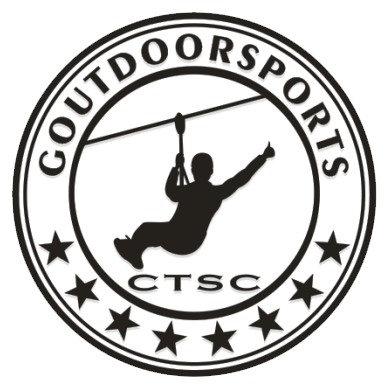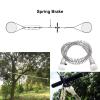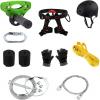Best Zip Lines in the market
 Pros
The braking system will ensure that your child will remain safe when using the product. The weight limit is up to 200 pounds. Quick and easy to set up.
Cons
Wrapping the ends around a tree will significantly shorten the length of the line. The trolley is hard to remove.
Pros
The braking system will ensure that your child will remain safe when using the product. The weight limit is up to 200 pounds. Quick and easy to set up.
Cons
Wrapping the ends around a tree will significantly shorten the length of the line. The trolley is hard to remove.
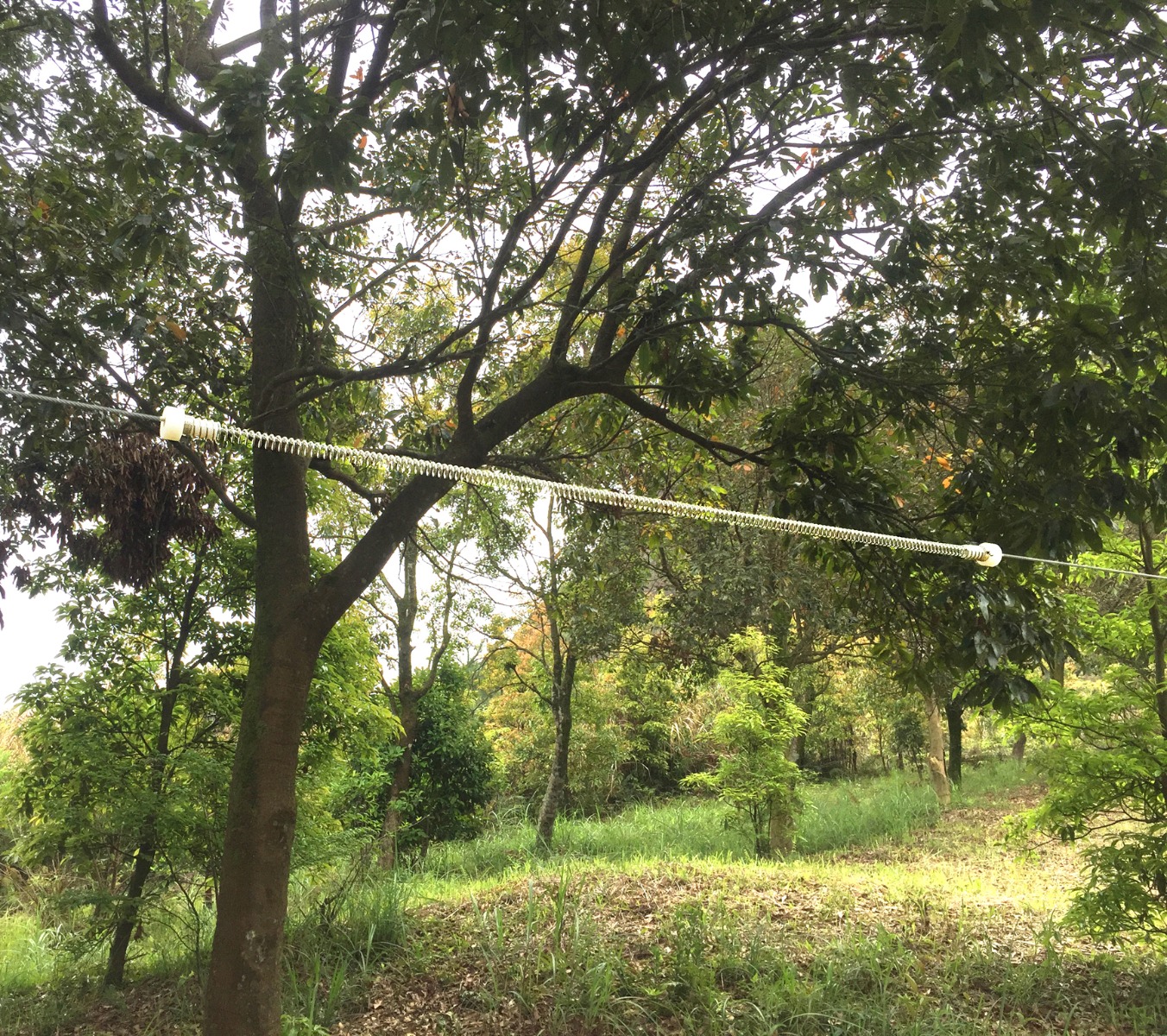 Pros
Stands out for being very easy to set up, with clear, detailed instructions. Affordable. A good choice for beginners and those with some experience. Attentive customer service.
Cons
Experienced users may be disappointed that it only has 60 feet of zip line.
Cons
Short ride. Tree attachment is not always a straightforward task. Younger users may not be able to reach handlebars.
Cons
Short ride. Tree attachment is not always a straightforward task. Younger users may not be able to reach handlebars.
Pros
Stands out for being very easy to set up, with clear, detailed instructions. Affordable. A good choice for beginners and those with some experience. Attentive customer service.
Cons
Experienced users may be disappointed that it only has 60 feet of zip line.
Cons
Short ride. Tree attachment is not always a straightforward task. Younger users may not be able to reach handlebars.
Cons
Short ride. Tree attachment is not always a straightforward task. Younger users may not be able to reach handlebars.
 Pros
Complete package that includes seat and braking system. Sturdy weight limit and 95 feet of zip line mean hours of fun for kids and adults. Not too difficult to set up.
Cons
Occasional quality control issues upon delivery, but customer service is helpful.
Pros
Complete package that includes seat and braking system. Sturdy weight limit and 95 feet of zip line mean hours of fun for kids and adults. Not too difficult to set up.
Cons
Occasional quality control issues upon delivery, but customer service is helpful.
 Buying guide for Best Zip Lines
For a barbecue or backyard gathering, a zip line can be fun for children as well as adults. There is a variety of zip lines on the market, however, and these vary in cable length, style, and carrying capacity.
If you’re concerned about safety, there are shorter zip lines with seats or harnesses, and as long as you have a good pair of trees, posts, or buildings to use as anchors, your zip line can be higher or lower to the ground depending on your comfort level.
This shopping guide will help you find the best zip line for your property. If you’re ready to buy a zip line, look at our top picks. Otherwise, keep reading.
Buying guide for Best Zip Lines
For a barbecue or backyard gathering, a zip line can be fun for children as well as adults. There is a variety of zip lines on the market, however, and these vary in cable length, style, and carrying capacity.
If you’re concerned about safety, there are shorter zip lines with seats or harnesses, and as long as you have a good pair of trees, posts, or buildings to use as anchors, your zip line can be higher or lower to the ground depending on your comfort level.
This shopping guide will help you find the best zip line for your property. If you’re ready to buy a zip line, look at our top picks. Otherwise, keep reading.
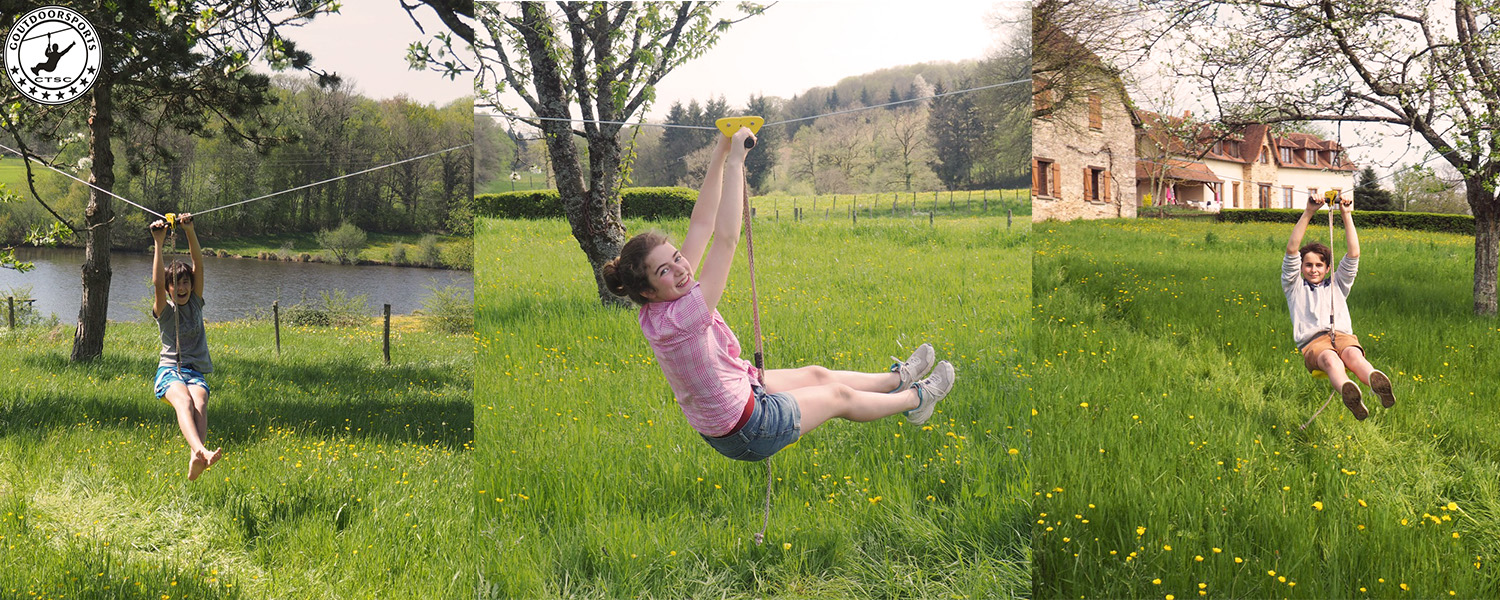 Before using your newly installed zip line, test the maximum load with a test weight to make sure the cable and anchors are secure.
Zip line features to consider
How will your zip line be used, who will be using it, and where do you plan to set it up? What is the weather like in your area? Do you have a safe location with secure anchors? These are all important questions to ask when considering different zip line models and styles.
Cable length
Zip line cables vary in length from 60 feet to 500 feet. A longer cable generally means faster rides and an increase in height, as the lines bow in the middle. Longer cables are often thicker to support their own weight. And with the added length comes added speed and the need for a reliable braking system.
Handlebar, seat, or harness
Different cable lengths and riders call for different riding gear. Each has advantages, and each is better for certain situations or locations.
Handlebar: The simplest and most common way to ride a zip line is by holding both sides of a handlebar that connects directly to the trolley or hangs from a carabiner. A handlebar is often paired with a harness for maximum security. This is a classic, easy-to-use design that works best on shorter cables at lower heights.
Before using your newly installed zip line, test the maximum load with a test weight to make sure the cable and anchors are secure.
Zip line features to consider
How will your zip line be used, who will be using it, and where do you plan to set it up? What is the weather like in your area? Do you have a safe location with secure anchors? These are all important questions to ask when considering different zip line models and styles.
Cable length
Zip line cables vary in length from 60 feet to 500 feet. A longer cable generally means faster rides and an increase in height, as the lines bow in the middle. Longer cables are often thicker to support their own weight. And with the added length comes added speed and the need for a reliable braking system.
Handlebar, seat, or harness
Different cable lengths and riders call for different riding gear. Each has advantages, and each is better for certain situations or locations.
Handlebar: The simplest and most common way to ride a zip line is by holding both sides of a handlebar that connects directly to the trolley or hangs from a carabiner. A handlebar is often paired with a harness for maximum security. This is a classic, easy-to-use design that works best on shorter cables at lower heights.
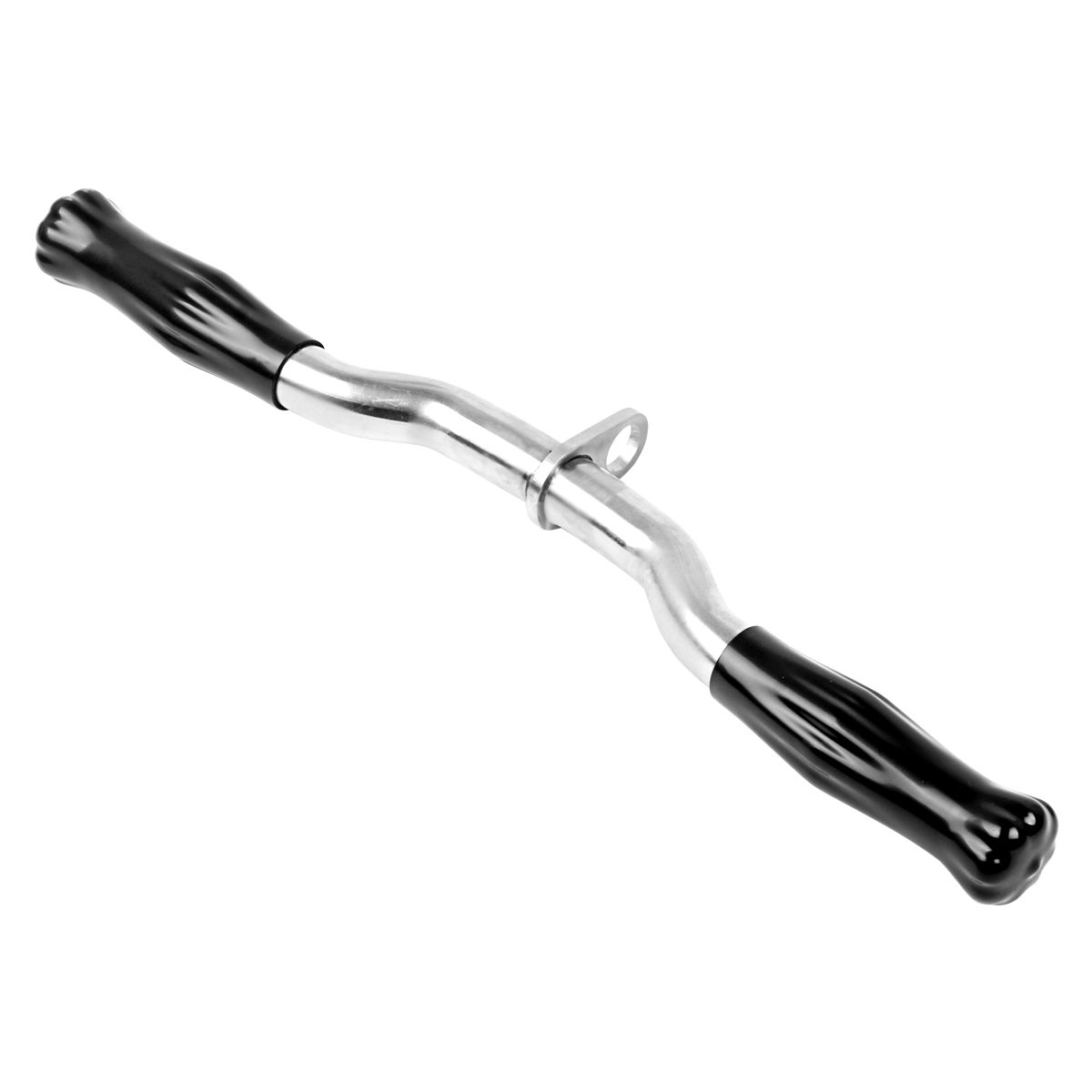 Seat: Usually circular in design and suspended from a thick rope or steel cable, a seat is a good choice for kids. Most seats are paired with a handlebar to prevent spinning. For shorter zip lines, this is a good choice that’s safer than a handlebar without a harness.
Harness: The most secure option is a harness that the rider wears. It attaches to the trolley via a lanyard and carabiner. Harnesses are essential when riding higher or longer zip lines. They may be used in conjunction with handlebars or seats.
Cable
The weight limit of most zip lines is based on cable length, material, and thickness. Cables range in diameter from 1/4 inch to 1/2 inch. While thicker cables are stronger, that doesn’t mean you want the thickest possible cable. For shorter zip lines, 1/4 inch is usually sufficient. It’s a good idea to stay well within the weight limit of your zip line kit.
Galvanized aircraft cable: Many zip line cables are made of galvanized aircraft cable, which is rated for the highest loads when compared with other cables of the same diameter.
Stainless steel cable: This is a common choice because of its durability and weather resistance. If you’re near the ocean, this is an ideal option. Stainless steel cables tend to be the most expensive.
Nylon- or vinyl-coated cable: This type provides a smooth and quiet ride, but it may be less durable than other materials. Over time, the plastic coating may begin to crack.
Trolley
Most zip line trolleys fall into one of two categories: fixed or quickly detachable. Bear in mind that not all trolleys fit the same cable size, though most will comfortably fit cables less than 1/2 inch in diameter. Some trolleys have built-in carabiners, and not all trolleys are compatible with manual brakes.
Fixed: A fixed trolley can’t be removed from the cable without disassembling the trolley itself. These also have a handle attached directly to the trolley. Fixed-handle trolleys like this can present a safety hazard if a braking system is in use, since the rider can hit their head on the handle.
Quickly detachable: Trolleys that can be easily removed from the cable are called quickly detachable trolleys. These are more commonly used by experienced zip liners. With a quickly detachable trolley, the riding equipment must be attached via carabiner. These are less likely to wear out quickly since less movement and momentum is transferred from the rider to the trolley.
Braking system
Know how your riders will stop before you set up your zip line. Stopping by planting your feet on the tree is not an option. The two types of braking system used by zip lines are active and passive.
Active braking system: This system gives the riders control over when and how quickly they stop. Due to the nature of this system, it is better suited to older or more experienced riders.
The most common type of active braking system is a pair of leather gloves. Riders slow themselves down by gently gripping the cable behind the trolley. Kids are not suggested to use gloves due to safety concern.
Other active braking systems involve a mechanism on the line that attaches to the trolley.
Passive braking system: The safest option is a system that works without any decision or action on the part of the rider. There are several options for passive braking systems:
Gravity brake: This brake system comes with every zip line kit. It is a natural brake formed by slack in the line or an elevated end point. The slack brings the rider to a stop naturally, though this can take some time. Gravity brakes reduce the overall distance traveled by the rider on the cable.
Spring brake: This system is a metal spring on the cable itself that compresses when it makes contact with the trolley. Like the gravity brake, this system usually takes time as the rider bounces to a halt.
Seat: Usually circular in design and suspended from a thick rope or steel cable, a seat is a good choice for kids. Most seats are paired with a handlebar to prevent spinning. For shorter zip lines, this is a good choice that’s safer than a handlebar without a harness.
Harness: The most secure option is a harness that the rider wears. It attaches to the trolley via a lanyard and carabiner. Harnesses are essential when riding higher or longer zip lines. They may be used in conjunction with handlebars or seats.
Cable
The weight limit of most zip lines is based on cable length, material, and thickness. Cables range in diameter from 1/4 inch to 1/2 inch. While thicker cables are stronger, that doesn’t mean you want the thickest possible cable. For shorter zip lines, 1/4 inch is usually sufficient. It’s a good idea to stay well within the weight limit of your zip line kit.
Galvanized aircraft cable: Many zip line cables are made of galvanized aircraft cable, which is rated for the highest loads when compared with other cables of the same diameter.
Stainless steel cable: This is a common choice because of its durability and weather resistance. If you’re near the ocean, this is an ideal option. Stainless steel cables tend to be the most expensive.
Nylon- or vinyl-coated cable: This type provides a smooth and quiet ride, but it may be less durable than other materials. Over time, the plastic coating may begin to crack.
Trolley
Most zip line trolleys fall into one of two categories: fixed or quickly detachable. Bear in mind that not all trolleys fit the same cable size, though most will comfortably fit cables less than 1/2 inch in diameter. Some trolleys have built-in carabiners, and not all trolleys are compatible with manual brakes.
Fixed: A fixed trolley can’t be removed from the cable without disassembling the trolley itself. These also have a handle attached directly to the trolley. Fixed-handle trolleys like this can present a safety hazard if a braking system is in use, since the rider can hit their head on the handle.
Quickly detachable: Trolleys that can be easily removed from the cable are called quickly detachable trolleys. These are more commonly used by experienced zip liners. With a quickly detachable trolley, the riding equipment must be attached via carabiner. These are less likely to wear out quickly since less movement and momentum is transferred from the rider to the trolley.
Braking system
Know how your riders will stop before you set up your zip line. Stopping by planting your feet on the tree is not an option. The two types of braking system used by zip lines are active and passive.
Active braking system: This system gives the riders control over when and how quickly they stop. Due to the nature of this system, it is better suited to older or more experienced riders.
The most common type of active braking system is a pair of leather gloves. Riders slow themselves down by gently gripping the cable behind the trolley. Kids are not suggested to use gloves due to safety concern.
Other active braking systems involve a mechanism on the line that attaches to the trolley.
Passive braking system: The safest option is a system that works without any decision or action on the part of the rider. There are several options for passive braking systems:
Gravity brake: This brake system comes with every zip line kit. It is a natural brake formed by slack in the line or an elevated end point. The slack brings the rider to a stop naturally, though this can take some time. Gravity brakes reduce the overall distance traveled by the rider on the cable.
Spring brake: This system is a metal spring on the cable itself that compresses when it makes contact with the trolley. Like the gravity brake, this system usually takes time as the rider bounces to a halt.
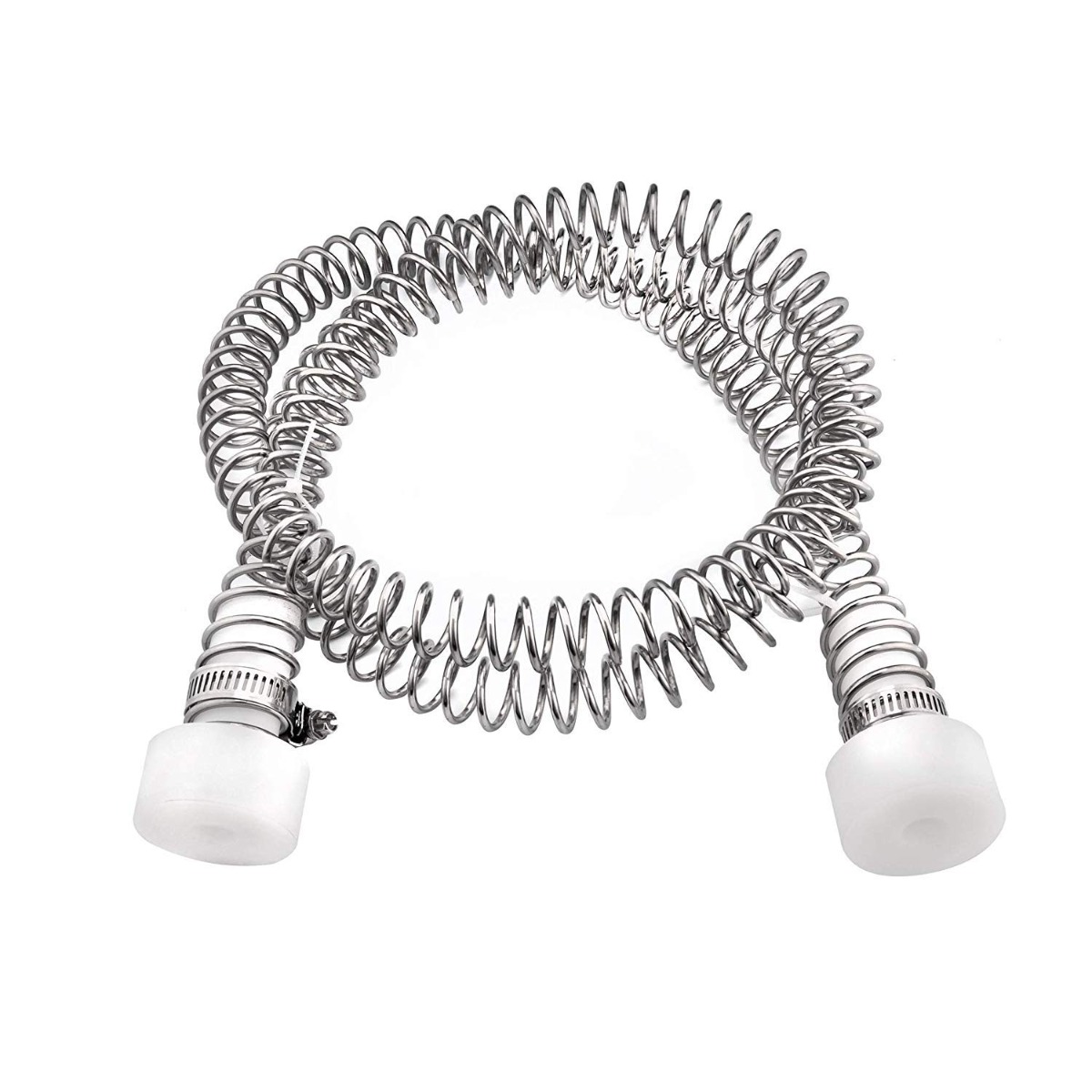 Brake block: A brake block is attached to a nearby tree or post with a bungee cord and sits on the end of the cable. When the trolley hits the block, the block begins to slow the rider as the bungee cord stretches.
Brake block: A brake block is attached to a nearby tree or post with a bungee cord and sits on the end of the cable. When the trolley hits the block, the block begins to slow the rider as the bungee cord stretches.
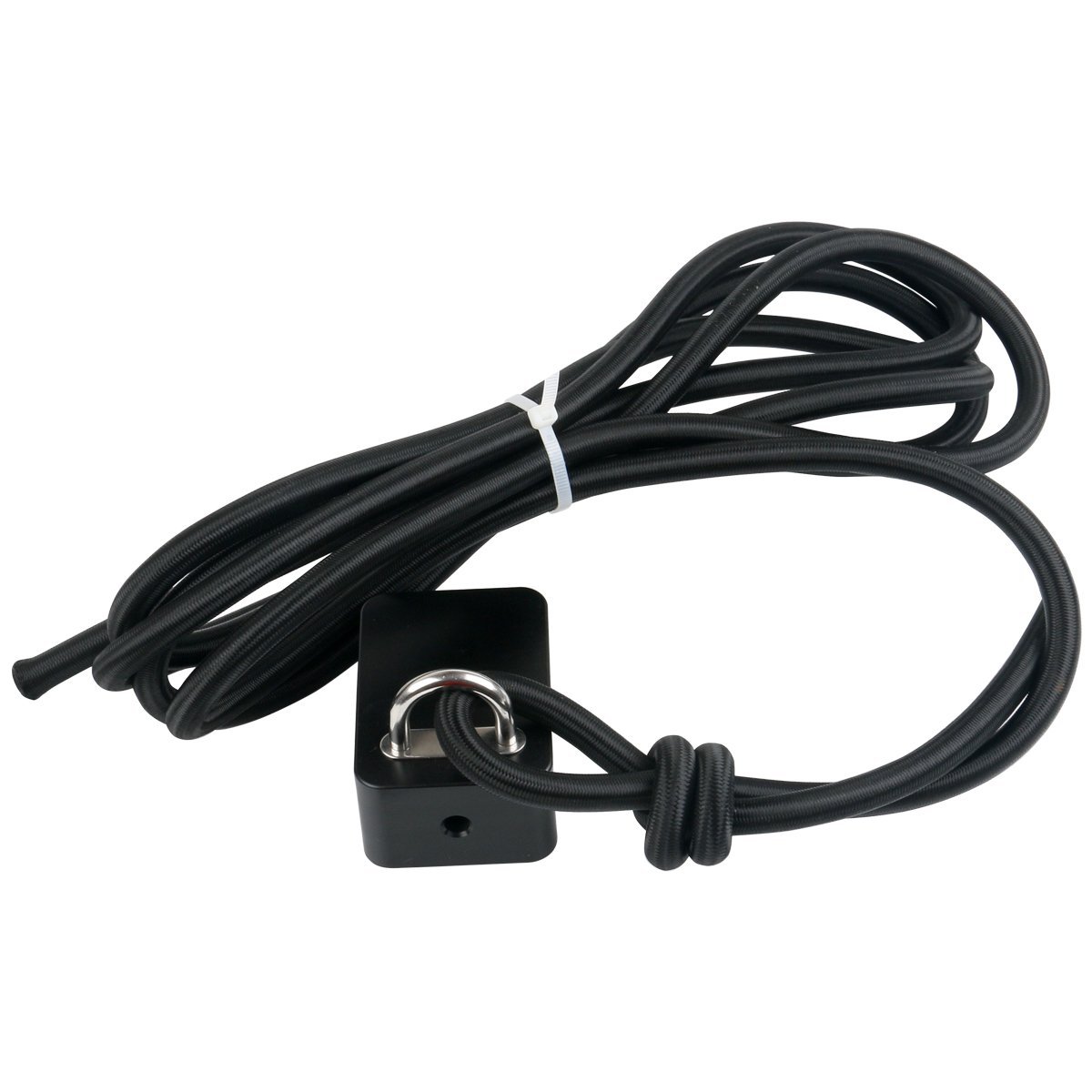 Installation
Wrapping and through-bolting are the two primary methods of connecting a zip line to anchors. Not all kits are designed for both setups, so check the manufacturer’s recommendation in the accompanying manual.
Wrapping: Compared to through-bolting, wrapping is relatively easy and requires few tools. The cable simply wraps around both anchor points and reattaches to itself with cable clamps. Many kits include everything you need to wrap your cables to trees or posts. It’s easy to inspect your cables to ensure that everything is secure. Note that if you leave the cable in place for a long time, it can do serious harm to the tree. Tree protection can be a worthwhile investment.
Installation
Wrapping and through-bolting are the two primary methods of connecting a zip line to anchors. Not all kits are designed for both setups, so check the manufacturer’s recommendation in the accompanying manual.
Wrapping: Compared to through-bolting, wrapping is relatively easy and requires few tools. The cable simply wraps around both anchor points and reattaches to itself with cable clamps. Many kits include everything you need to wrap your cables to trees or posts. It’s easy to inspect your cables to ensure that everything is secure. Note that if you leave the cable in place for a long time, it can do serious harm to the tree. Tree protection can be a worthwhile investment.
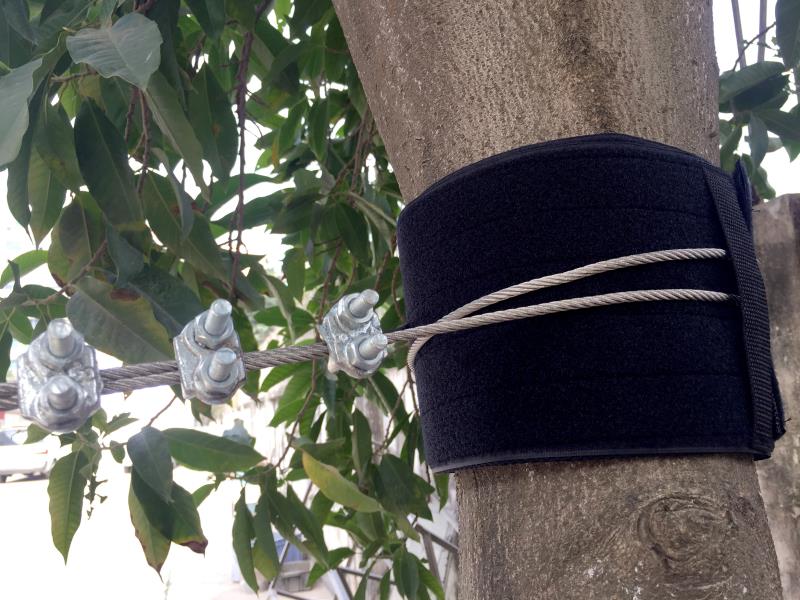 Through-bolting: This method requires a drill and an eye bolt, which should pass fully through the tree or post. This is less likely to damage the tree than wrapping, but it can’t be adjusted the way wrapping can.
Did you know?
Some zip line cables have a thread core instead of a steel core. For maximum durability and load, choose a cable with a steel core.
Zip line prices
The cost of a zip line kit varies based on cable length, trolley type, riding gear, and additional accessories included, such as stop blocks. Expect to pay between $70 and $1,000 for a zip line.
Did you know?
Some zip line cables have a thread core instead of a steel core. For maximum durability and load, choose a cable with a steel core.
Did you know?
Some zip line cables have a thread core instead of a steel core. For maximum durability and load, choose a cable with a steel core.
STAFF
BestReviews
Zip line prices
The cost of a zip line kit varies based on cable length, trolley type, riding gear, and additional accessories included, such as stop blocks. Expect to pay between $70 and $1,000 for a zip line.
Inexpensive
Smaller zip line kits designed for children fall in the range of $70 to $150. These are usually 35 to 100 feet long.
Mid-range
For $150 to $300, you can get a zip line kit with an 80- to 200-foot cable. Kits in this range may also include accessories like spring brakes or harnesses.
Expensive
In the range of $300 to $1,000, you can find higher-end zip line kits with cable lengths up to 1,000 feet. These kits are almost always designed for adults and installed high above the ground. Harnesses are usually required for kits of this type.
Through-bolting: This method requires a drill and an eye bolt, which should pass fully through the tree or post. This is less likely to damage the tree than wrapping, but it can’t be adjusted the way wrapping can.
Did you know?
Some zip line cables have a thread core instead of a steel core. For maximum durability and load, choose a cable with a steel core.
Zip line prices
The cost of a zip line kit varies based on cable length, trolley type, riding gear, and additional accessories included, such as stop blocks. Expect to pay between $70 and $1,000 for a zip line.
Did you know?
Some zip line cables have a thread core instead of a steel core. For maximum durability and load, choose a cable with a steel core.
Did you know?
Some zip line cables have a thread core instead of a steel core. For maximum durability and load, choose a cable with a steel core.
STAFF
BestReviews
Zip line prices
The cost of a zip line kit varies based on cable length, trolley type, riding gear, and additional accessories included, such as stop blocks. Expect to pay between $70 and $1,000 for a zip line.
Inexpensive
Smaller zip line kits designed for children fall in the range of $70 to $150. These are usually 35 to 100 feet long.
Mid-range
For $150 to $300, you can get a zip line kit with an 80- to 200-foot cable. Kits in this range may also include accessories like spring brakes or harnesses.
Expensive
In the range of $300 to $1,000, you can find higher-end zip line kits with cable lengths up to 1,000 feet. These kits are almost always designed for adults and installed high above the ground. Harnesses are usually required for kits of this type.
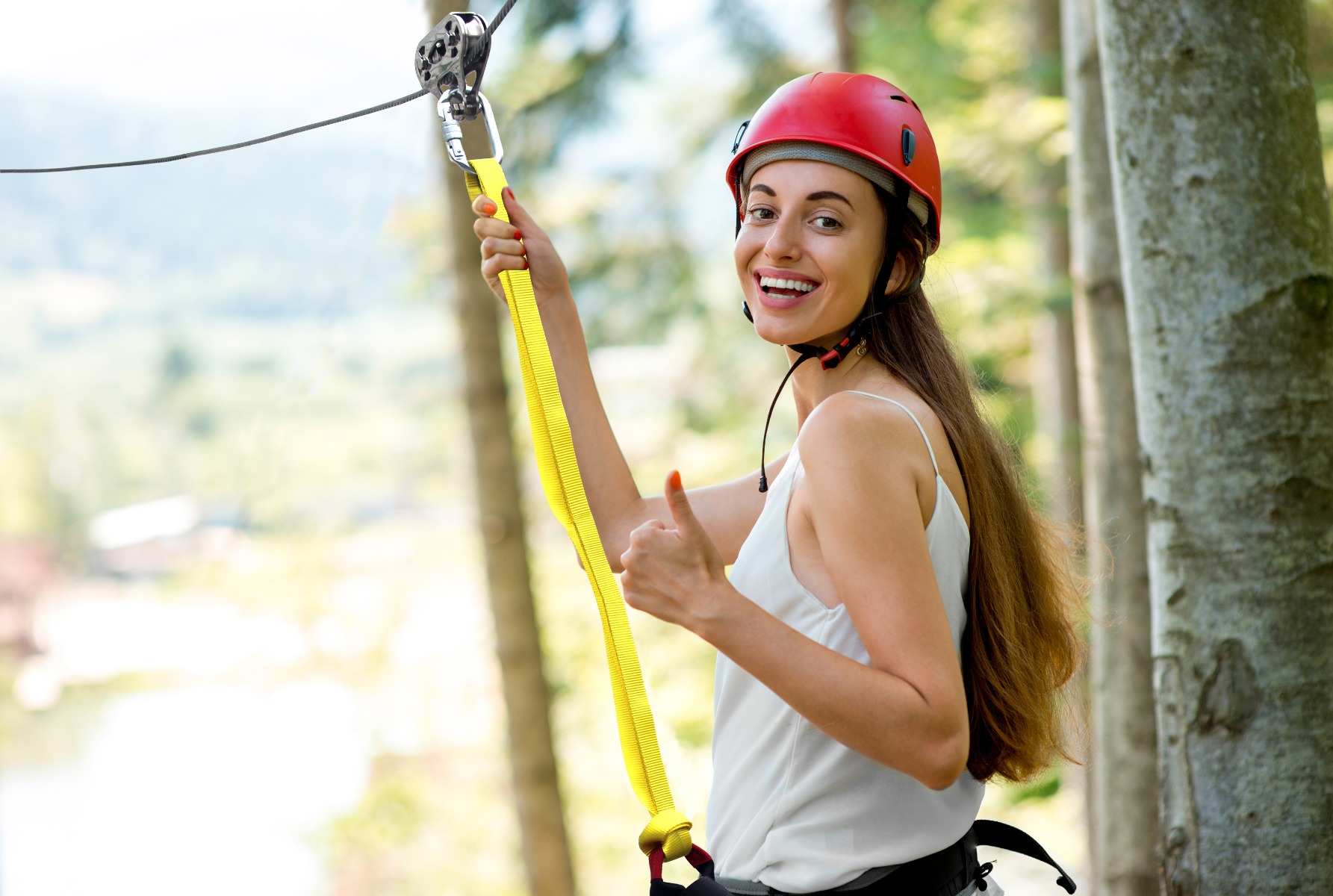 Always keep the area below the zip line free of obstacles and hard or sharp objects to minimize injury in the event of a fall.
FAQ
Q. How safe are zip lines?
A. That depends on the height and length of the cable, the style of the trolley, riding gear, and braking system, and the rider’s experience level. There is a risk of injury with any high-speed outdoor activity, but you can take precautions to minimize risk, such as checking the cable, anchors, and equipment frequently and ensuring that all riders follow manufacturer recommendations for riding.
Q. Should riders wear helmets?
A. Yes. A helmet is a good idea for riders of any age or experience level. Not only does a helmet protect you in the case of a fall but it also keeps loose strands of hair from becoming tangled in the trolley or other moving parts. Not all zipline kits include a helmet so sometimes the helmet will be purchased seperately from a professonal seller like CTSC.
Always keep the area below the zip line free of obstacles and hard or sharp objects to minimize injury in the event of a fall.
FAQ
Q. How safe are zip lines?
A. That depends on the height and length of the cable, the style of the trolley, riding gear, and braking system, and the rider’s experience level. There is a risk of injury with any high-speed outdoor activity, but you can take precautions to minimize risk, such as checking the cable, anchors, and equipment frequently and ensuring that all riders follow manufacturer recommendations for riding.
Q. Should riders wear helmets?
A. Yes. A helmet is a good idea for riders of any age or experience level. Not only does a helmet protect you in the case of a fall but it also keeps loose strands of hair from becoming tangled in the trolley or other moving parts. Not all zipline kits include a helmet so sometimes the helmet will be purchased seperately from a professonal seller like CTSC.
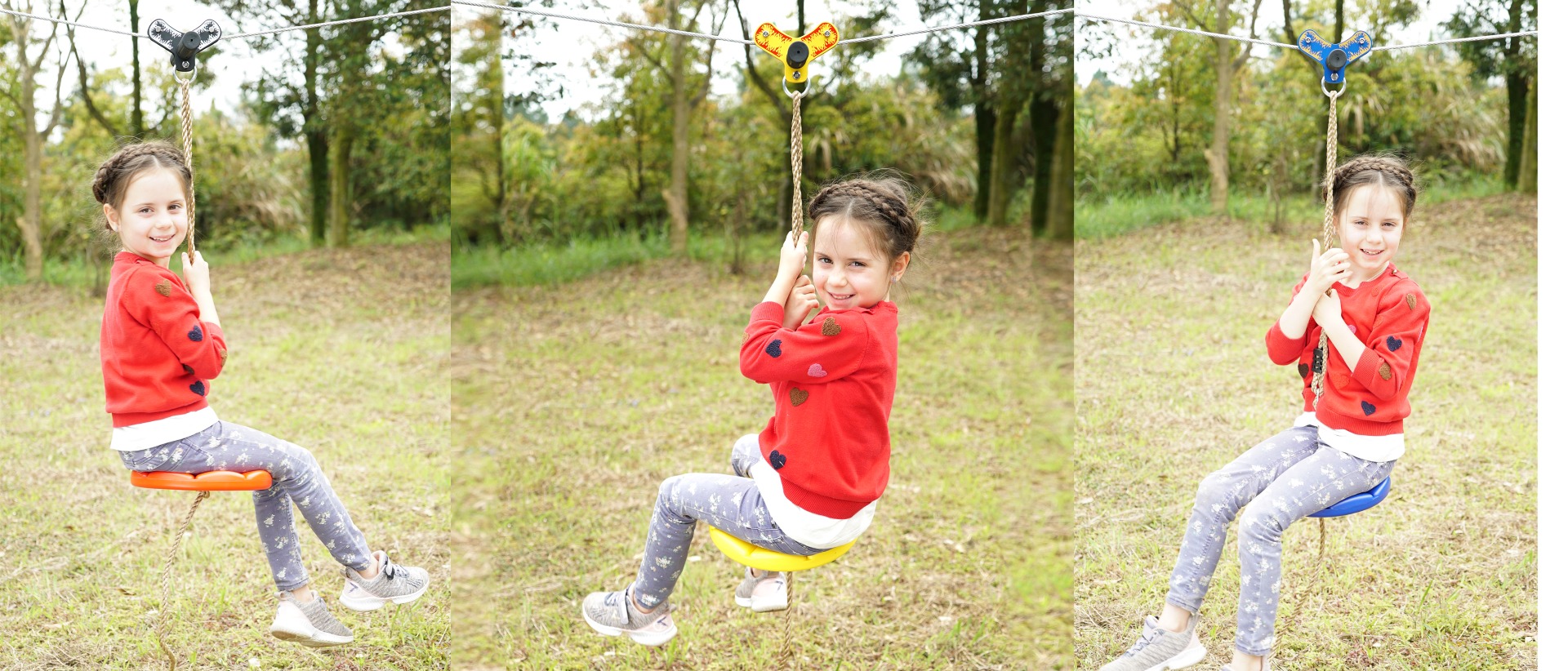
December 4, 2021
